Students must start practicing the questions from CBSE Sample Papers for Class 11 Physics with Solutions Set 3 are designed as per the revised syllabus.
CBSE Sample Papers for Class 11 Physics Set 3 with Solutions
Time Allowed : 3 hours
Maximum Marks : 70
General Instructions:
- There are 33 questions in all. All questions are compulsory.
- This question paper has five sections: Section A, Section B, Section C, Section D and Section E.
- All the sections are compulsory.
- Section A contains sixteen questions, twelve MCQ and four Assertion Reasoning based of 1 mark each, Section B contains five questions of two marks each, Section C contains seven questions of three marks each, Section D contains two case study based questions of four marks each and Section E contains three long answer questions of five marks each.
- There is no overall choice. However, an internal choice has been provided in one question in Section B, one question in Section C, one question in each CBQ in Section D and all three questions in Section E. You have to attempt only one of the choices in such questions
- Use of calculators is not allowed.
- You may use the following values of physical constants where ever necessary
- c = 3 × 10 8 m/s
- me = 9.1 × 10 -31 kg
- µ 0 = 4π × 10 -7 TmA -1
- ε 0 = 8.854 × 10 -12 × C 2 N -1 m -2
- Avogadro’s number = 6.023 × 10 23 per gram mole
Section – A
Question 1.
Which one of the following is correct representation of current?
(A) 5 a
(B) 5 Ampere
(C) 5 ampere
(D) 5 amperes
Answer:
(C) 5 ampere
Explanation:
When symbolically written, the first letter of the unit in the name of scientist should be a capital letter. But when the unit is written in complete word form then it should be written in small letters.
Question 2.
Which of the following is not possible for a body in uniform motion?
(A)
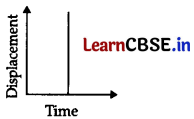
(B)
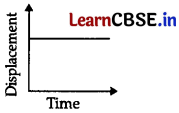
(C) Both (A) and (B)
(D) None of these
Answer:
(C) Both (A) and (B)
Explanation:
In fig (A) time remaining constant displacement varies. This is not possible.
In fig (B), displacement does not change with time. Hence, the body is not in motion. It is at rest.
Question 3.
A partide is projected making an angle 600 with the horizon, with K amount of kinetic energy. The kinetic energy of the partide at the highest position is
(A) 0
(B) \(\frac{K}{2}\)
(C) \(\frac{K}{4}\)
(D) K
Answer:
(C) \(\frac{K}{4}\)
Explanation:
Initial velocity = υ
Initial kinetic energy = \(\frac{1}{2}\) mυ
2
= K
At the highest position velocity = υ cos 60° = \(\frac{v}{2}\)
∴ Kinetic energy = \(\frac{1}{2} m\left(\frac{v}{2}\right)^2\)
= \(\frac{1}{4}\left(\frac{1}{2} m v^2\right)\)
= \(\frac{K}{4}\)
![]()
Question 4.
A lift having mass 100 kg is rising up with an acceleration 4 m/s
2
. The tension in the string is
(A) 1380 N
(B) 1160 N
(C) 2380 N
(D) 580 N
Answer:
(A) 1380 N
Explanation:
When the lift is rising up,
T = m (g + a)
Or, T = 100 × (9.8 + 4)
∴ T = 1380 N
Question 5.
Conservation of momentum in a collision between particles follows
(A) Conservation of energy
(B) Newton’s first law only.
(C) Newton’s second law only
(D) Both Newton’s second and third law
Answer:
(D) Both Newton’s second and third law
Question 6.
The horizontal range of a projectile fired at an angle of 15° is 10 m. If it is fired with the same speed at an angle of 30°, its range will be
(A) 10 √3 m
(B) \(\frac{10}{\sqrt{3}}\) m
(C) \(\frac{\sqrt{3}}{10}\) m
(D) None of these
Answer:
(A) 10 √3 m
Explanation:
R = \(\frac{u^2 \sin 2 \theta}{g}\) ; R α sin 2θ
∴ \(\frac{R_1}{R_2}=\frac{\sin 2 \times 15^{\circ}}{\sin 2 \times 30^{\circ}}\)
= \(\frac{\sin 30^{\circ}}{\sin 60^{\circ}}\)
= \(\frac{1}{\sqrt{3}}\)
R
2
= 10√3 m
![]()
Question 7.
A body of mass 100 g falls from a height of 10 m. Its increase in kinetic energy is
(A) 9800 J
(B) 9.8 J
(C) 980 J
(D) 100 J
Answer:
(B) 9.8 J
Explanation:
Loss of PE = Gain in KE
Loss in PE = mgh
= (\(\frac{100}{1000}\)) × 9.8 × 10 – 9.8 J
So, increase in KE = 98 J
Question 8.
Which of the following have the same moment of inertia?
(A) (i) Moment of inertia of a thin circular ring of radius R about an axis perpendicular to the plane, through the centre.
(ii) Moment of inertia of a hollow cylinder of radius R about the axis of the cylinder.
(B) (i) Moment of inertia of a thin circular ring of radius R about an axis perpendicular to the plane, through the centre.
(ii) Moment of inertia of a solid cylinder of radius R about the axis of the cylinder.
(C) (i) Moment of inertia of a thin circular ring of radius R about an axis perpendicular to the plane, through the centre.
(ii) Moment of inertia of a solid sphere of radius R about the diameter of the sphere.
(D) (i) Moment of inertia of a solid cylinder of radius R about the axis of the cylinder.
(ii) Moment of inertia of a hollow cylinder of radius R about the axis of the cylinder.
Answer:
(A) (i) Moment of inertia of a thin circular ring of radius R about an axis perpendicular to the plane, through the centre.
(ii) Moment of inertia of a hollow cylinder of radius R about the axis of the cylinder.
Explanation:
In both cases moment of inertia is MR
2
.
Question 9.
Two particles of equal mass m are moving along a circle of radius r under the action of their mutual gravitational attraction. The speed of each particle is
(A) \(\sqrt{\frac{G m}{4 r}}\)
(B) \(\sqrt{\frac{G m}{2 r}}\)
(C) \(\sqrt{\frac{G m}{r}}\)
(D) \(\sqrt{G m r}\)
Answer:
(A) \(\sqrt{\frac{G m}{4 r}}\)
Explanation:
Gravitational attraction between the two particles = F = \(\frac{G m^2}{(2 r)^2}\)
Required centripetal force = \(\frac{m v^2}{r}\)
∴ \(\frac{G m^2}{4 r^2}=\frac{m v^2}{r}\)
∴ v = \(\sqrt{\frac{G m}{4 r}}\)
![]()
Question 10.
Which of the following cannot be the value of Poisson’s ratio?
(A) 0.1
(B) 0.3
(C) 0.5
(D) 0.8
Answer:
(D) 0.8
Explanation: Value of Poisson’s ratio lies between 0 and 0.5.
Question 11.
The ratio of specific heats for monoatomic and rigid diatomic gases are respectively
(A) \(\frac{9}{7}, \frac{5}{3}\)
(B) \(\frac{9}{5}, \frac{7}{3}\)
(C) \(\frac{5}{3}, \frac{7}{5}\)
(D) \(\frac{3}{5}, \frac{7}{9}\)
Answer:
(C) \(\frac{5}{3}, \frac{7}{5}\)
Explanation:
The molecule of a monatomic gas has only three translational degrees of freedom.
So, C
V
= \(\frac{5}{2}\) R
Since, C
P
– C
V
= R
∴ C
P
= \(\frac{5}{2}\) R
\(\frac{C_P}{C_V}=\frac{5}{3}\)
A diatomic molecule treated having a rigid dumbbell shape has 3 translational and 2 rotational degrees of freedom.
So, C
V
= \(\frac{5}{2}\) R
Since, C
P
– C
V
= R
∴ C
P
= \(\frac{7}{2}\) R
\(\frac{C_P}{C_V}=\frac{7}{5}\)
Question 12.
In a stationary wave, the distance between two consecutive nodes is.
(A) \(\frac{\lambda}{4}\)
(B) \(\frac{\lambda}{2}\)
(C) λ
(D) 2λ
Answer:
(B) \(\frac{\lambda}{2}\)
![]()
For Questions 13 to 16. TVvo statements are given- one labelled Assertion (A) and other labelled Reason (R). Select the correct answer to these questions from the options as given below.
(A) If both Assertion and Reason are true and Reason is the correct explanation of Assertion.
(B) If both Assertion and Reason are true but Reason is not the correct explanation of Assertion.
(C) If Assertion is true but Reason is false.
(D) If both Assertion and Reason are false.
Question 13.
Assertion (A) : A projectile is projected at an angle θ and then at an apgle 90° – θ, keeping the velocity same. In both the cases, the range will be same.
Reason (R) : Range of a projectile = R = \(\frac{u^2 \sin \theta}{g}\)
Answer:
(C) If Assertion is true but Reason is false.
Explanation:
R = \(\frac{u^2 \sin 2 \theta}{g}\)
When angle of projection = 90° – then
R’ = \(\frac{u^2 \sin 2\left(90^{\circ}-\theta\right)}{g}\)
= \(\frac{u^2 \sin \left(180^{\circ}-2 \theta\right)}{g}\)
= \(\frac{u^2 \sin 2 \theta}{g}\)
= 2R
So, the assertion is true but the reason is false.
Question 14.
Assertion (A) : Area under velocity time graph gives the acceleration.
Reason (R) : The position time graph of an object moving with constant acceleration is a straight line parallel to time axis.
Answer:
(D) If both Assertion and Reason are false.
Explanation:
The slope of velocity time graph gives the acceleration. Hence, the assertion is false.
The position time graph of an object moving with constant acceleration is a straight line passing through the origin making an angle with the time axis. Hence, the reason is also false.
Question 15.
Assertion (A) : The kinetic energy of the body of mass 2 kg and momentum of 2 Ns is 1 J.
Reason (R) : The relation between kinetic energy and linear momentum of an object is given by
Answer:
(C) If Assertion is true but Reason is false.
Explanation:
K = \(\frac{p^2}{2 m}\)
Or, K = \(\frac{2^2}{2 \times 2}\)
∴ K = 1 J
So, the assertion is true. But the reason is false.
Question 16.
Assertion (A) : Centre of mass of an object is a point where the whole mass of the body is assumed to be concentrated.
Reason (R) : Centre of mass of an object cannot lie where there is no mass.
Answer:
(C) If Assertion is true but Reason is false.
Explanation:
Centre of mass of an object is a point where the whole mass of the body is assumed to be concentrated. The assertion is true.
It may lie even there is no mass, e.g., a ring, a curved banana, a hollow sphere, etc.
So, the reason is false.
![]()
Section – B
Question 17.
Is circular motion possible at constant speed or at constant velocity? Explain.
Answer:
Circular motion is possible at constant speed because in circular motion, the magnitude of the velocity, i.e., speed remains constant while the direction of motion changes continuously.
Question 18.
Does the nature of a vector change when it is multiplied by a scalar?
Answer:
The nature of a vector may or may not be changed when it is multiplied.
For example, when a vector is multiplied by a pure number like 1, 2, 3, …………… etc., then the nature of the vector does not change.
On the other hand, when a vector is multiplied by a scalar physical quantity, then the nature of the vector changes. For example, when acceleration
(vector) is multiplied by mass (scalar) of a body, then it gives force (a vector quantity) whose nature is different than acceleration.
Question 19.
What is Kepler’s heliocentric theory?
Answer:
According to this theory, all planets revolve around the Sun in elliptical orbits with Sun as one of the foci.

Question 20.
Why the speed of whirl wind in a Tornado is alarmingly high?
Answer:
In whirl wind, air from wide regions get concentrated in a small space, so I is considerably less.
Since, Iω = constant so ω is so high.
Question 21.
Show that in S.H.M., the acceleration is directly proportional to its displacement at the given instant.
Answer:
In S.H.M., the displacement of the particle at an instant is given by:
y = r sin ωt.
Velocity, v = \(\frac{d y}{d t}\)
= rω cos ωt
Acceleration, a = \(\frac{d y}{d t}\)
= – ω
2
r sin ωt
= – ω
2
y
From the above equation, we note that a ay, i.e., acceleration is S.H.M. at an instant is directly proportional to the displacement of the particle from the mean position at that instant and opposite in direction.
OR
A vessel is placed below a water tap. We can estimate the height of the water level reached in the vessel from a distance simply by listening to the sound. Why?
Answer:
The frequency of sound produced in an air column is inversely proportional to the length of the air column. As level of water in the vessel increases, length of air column above it decreases. Hence the frequency of sound produced goes on increasing. The sound becomes shriller.
![]()
Section – C
Question 22.
Give position-time graphs for one object moving with negative velocity, moving with positive velocity and at rest.
Answer:
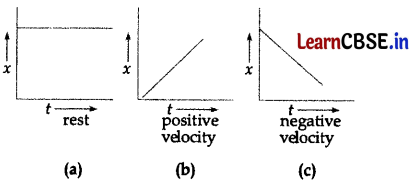
Question 23.
An object moving on a straight line covers first half of the distance at speed y and second half of the distance at speed 2υ. Find (i) average speed, (ii) mean speed.
Answer:
Let total distance be x.
Distance of first half = \(\frac{x}{2}\)
speed = v
Time taken, t
1
= \(\frac{\frac{x}{2}}{v}=\frac{x}{2 v}\)
Distance of second half = \(\frac{x}{2}\)
speed = 2v
time taken, t = \(\frac{\frac{x}{2}}{2 v}=\frac{x}{4 v}\)
(i) Average speed = \(\frac{\text { Total distance travelled }}{\text { Total time taken }}\)
= \(\frac{x}{\frac{x}{2 v}+\frac{x}{4 v}}=\frac{4 v}{3}\)
(ii) Mean speed = \(\frac{v+2 v}{2}=\frac{3 v}{2}\)
Question 24.
State and derive work – energy relationship.
Answer:
It states that change in kinetic energy of a body is equal to work done and vice versa.
Let a constant force \(\vec{F}\) be applied to a body moving with initial velocity \(\vec{u}\), so that its velocity becomes \(\vec{v}\) along the direction of force when s is its displacement.
Using Newton’s second law of motion we get magnitude of force F = ma and from equation of motion, we get v
2
– u
2
= 2as, where a is the acceleration of the body.
Multiplying both sides by m/2, we get
\(\frac{1}{2}\) mv
2
– \(\frac{1}{2}\) mu
2
= mas
i.e., \(\frac{1}{2}\) mv
2
– \(\frac{1}{2}\) mu
2
= Fs = W
i.e., K.E.
(f)
= K.E.
(i)
= W
where K.E.
(f)
is final kinetic energy and K.E.
(i)
is initial kinetic energy.
Thus work done on a body by a net force is equal to the change in kinetic energy of the body.
![]()
Question 25.
State Pascal’s law of transmission of fluid pressure. Explain how is Pascal’s law applied in a hydraulic lift. (with suitable diagram).
Answer:
Pascal law :
If gravity effect is neglected, the pressure at every point of liquid in equilibrium at rest is same.
Hydraulic lift. It is used to lift the heavy loads. Its working is based on Pascal’s law. A simple hydraulic lift is shown in figure. Here, C and D are two cylinders of different areas of cross section. They are connected to each other with a pipe E. Each cylinder is provided with airtight frictionless piston. Let a, and A be the areas of cross-sections of the pistons in C and D, respectively, where a < < A. The cylinders are filled with an incompressible liquid.
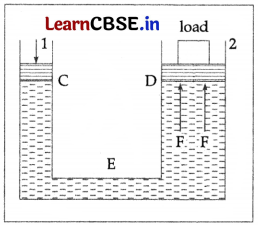
Let a downward force f be applied on the piston of C. Then the pressure exerted on the liquid, P = f/a.
According to Pascal’s law, this pressure is transmitted equally to piston of cylinder D.
∴ Upward force acting on the piston of cylinder D will be
F = PA
= \(\frac{f}{a}\) A
= f \(\frac{A}{a}\)
Question 26.
Two capillaries of same length and radii in the ratio 1 : 2 are connected in series. A liquid flows through them in a streamlined condition. If the pressure across the two extreme ends of the combination is 1 m of water, find the pressure difference across first capillary.
Answer:
Here, \(\frac{\pi P_1 r^4}{8 \eta l}=\frac{\pi P_2(2 r)^4}{8 \eta l}\)
i.e., P
1
= 16P
2
Given that P
1
+ P
2
= 1 m
P
1
+ \(\frac{P_1}{16}\) = 1
or P
1
= \(\frac{16}{17}\) = 0.94 m.
Question 27.
(a) What is an ‘Indicator diagram’ ? What is its importance?
Answer:
(a) Indicator diagram is the graphical representation of a thermodynamic system using two thermodynamic variables, e.g., P and V diagram.
Area under PV diagram gives work done in the thermodynamic progress.
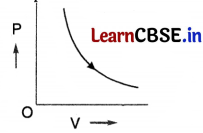
(b) What is the relation between heat energy, work done and change in internal energy?
Answer:
The relation is :
dQ = dU + dW
Question 28.
(a) The periodic time of a body executing S.H.M. is 2 s. After how much interval from t = 0, will its displacement be half of its amplitude?
Answer:
Here, T = 2s ; t = ?, y = a/2
Now, y = a sin ωt
= a sin πt (∵ T = 2s)
∴ \(\frac{a}{2}\) = a sin \(\frac{2 \pi}{T}\) t
= a sin πt
or sin πt = \(\frac{1}{2}\)
∴ sin πt = sin \(\frac{\pi}{6}\)
or πt = \(\frac{\pi}{6}\) or, t = \(\frac{1}{6}\) s.
(b) Can a motion be periodic but not oscillatory ? if yes, give an example. If not, explain why?
Answer:
Yes, uniform circular motion is the example of it.
OR
Explain the factors on which the pitch of a tuning fork depends.
Answer:
(i) Length of the prongs (l) : The pitch (v) is inversely proportional to the square of the length (l) of the prongs, i.e., v ∝ 1/l
2
(ii) Thickness of the prongs (b) : The pitch (v) is directly proportional to the thickness (b) of the prong, i.e., v ∝
(iii) Elasticity of the material (Y) : The pitch is directly proportional to the square root of the elasticity (Y) of the material, i.e., v ∝ \(\sqrt{Y}\)
(iv) Density of the material (ρ): The pitch (v) is inversely proportional to the square root of the density of the material, i.e., v ∝ \(\frac{1}{\sqrt{\rho}}\)
![]()
Section – D
Read the following text and answer the following questions on the basis ot the same:
Galileo’s Isochronous Pendulum:
Galileo observed a lamp swinging from ceiling at Pisa cathedral ceiling. He was the first scientist to observe how long it took any object suspended from a rope or chain (a pendulum) to swing back and forth. There were no wrist watches at that time, so Galileo used his own pulse as a time measurement. Galileo observed that no matter how big the swings were, as in when the lamp was first swung, to how big the swings were as the lamp returned to a standstill, the time it took for each swing to complete was exactly the same. So, he concluded that the oscillations are isochronous. Anyhow, it was proved by advanced experimentation that the isochronism of simple pendulum is correct within 1% under the 30° of amplitude. It is confirmed that the period changes less than 1% until the amplitude is 30°. On the other hand, the period increased by more than 10% when the amplitude became larger than 80°. At the end of his life he devised a scheme for using a pendulum to regulate a mechanical dock. However, the first reliable pendulum dock was only demonstrated by Huygens 15 years after Galileo’s death
(i) Who first observed the time period of a pendulum ?
(A) Aristotle
(B) Pythagoras
(C) Galileo
(D) Democritus
Answer:
(C) Galileo
Explanation:
Galileo observed a lamp swinging from ceiling at Pisa cathedral ceiling. He was the first scientist to observe how long it took any object suspended from a rope or chain (a pendulum) to swing back and forth.
(ii) How the time period of a pendulum was measured in the beginning of 16th century ?
(A) By a stop watch
(B) By using pulse beats
(C) By using vibration of a stringed instrument
(D) By using a sand dock
Answer:
(B) By using pulse beats
Explanation:
Since, no watches were available at that time, Galileo used his own pulse as a time measurement.
(iii) Galileo observed that the time period of the pendulum
(A) Does not vary with the size of swing
(B) Increases when the size of swing increases
(C) Decreases when the size of swing increases
(D) Unpredictable
Answer:
(A) Does not vary with the size of swing
Explanation:
Galileo observed that no matter how big the swings were, as in when the lamp was first swung, to how small the swings were as the lamp returned to a standstill, the time it took for each swing to complete was exactly the same.
OR
First reliable pendulum dock was only demonstrated by
(A) Vincenzo Viviani
(B) Huygens
(C) Maffeo Barberini
(D) Newton
Answer:
(B) Huygens
Explanation:
The first reliable pendulum clock was only demonstrated by Huygens 15 years after Galileo’s death.
(iv) Isochronism of simple pendulum is with in acceptable limit as long as the amplitude is under
(A) 90°
(B) 60°
(C) 30°
(D) 80°
Answer:
(C) 30°
Explanation:
Anyhow, it was proved by advanced experimentation that the isochronism of simple pendulum is correct Within 1% under the 30° of amplitude. It is confirmed that the period changes less than 1% until the amplitude is 30°. On the other hand, the period increased by more than 10% when the amplitude became larger than 80°.
Question 30.
Read the following text and answer the following questions on the basis of the same:
A gas which obeys the ideal gas equation PV = nRT at all temperature and pressure values is called an ideal gas equation. Molecules of such a gas are free from inter molecular attraction and have negligible volume. The gas particles are equally sized and motion of the particles follows Newton’s laws of motion. These particles do not undergo any energy loss as they have perfect elastic collisions. Figure shows plot of \(\frac{P V}{T}\) versus P for 1.00 × 10 -3 , kg of oxygen gas at two different temperatures.
(i) What does the dotted line signify in the above diagram?
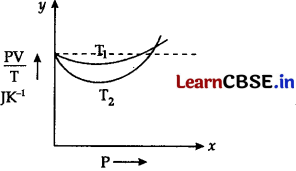
(A) Ideal gas behaviour
(B) Real gas behaviour
(C) Oxygen gas at temperature T
1
(D) Oxygen gas at temperature T
2
Answer:
(A) Ideal gas behaviour
Explanation:
The dotted line is a straight line parallel to P axis, so it signifies the ideal gas behaviour.
(ii) Which is of the following is correct ?
(A) T
1
< T
2
(B) T
1
> T
2
(C) T
1
= T
2
(D) T
1
≤ T
2
Answer:
(B) T
1
> T
2
Explanation:
The real gas approaches the ideal behaviour and the temperature increases. Since the plot of temperature T1 is close to the ideal behaviour, it can be concluded that T
1
> T
2
.
(iii) The value of \(\frac{P V}{T}\) where curves meet on y-axis is
(A) 8.31 JK
-1
(B) 0.26 JK
-1
(C) 0.52 JK
-1
(D) 4.15 JK
-1
Answer:
(B) 0.26 JK
-1
Explanation:
The ideal gas equation is given by
\(\frac{P V}{T}\) = nR
MO
2
= 32 g
nR = \(\frac{1}{32}\) × 8.314 JK
-1
= 0.259 JK
-1
(iv) Relation between Boltzmann constant and universal gas constant is
[k
B
= Boltzmann constant, R = Universal gas constant, N = Avogadro number]
(A) R = k
B
/N
(B) N = k
B
R
(C) k
B
= \(\frac{N}{R}\)
(D) R = k
B
N
Answer:
(D) R = k
B
N
OR
What will be the value of \(\frac{P V}{T}\) for 1.00 × 10
-3
kg of hydrogen gas if, the oxygen gas is replaced by hydrogen gas?
[Give: mass of hydrogen = 2.02 u]
(A) 2 JK
-1
(B) 16.8 JK
-1
(C) 8.3 JK
-1
(D) 4.112 JK
-1
Answer:
(D) 4.112 JK
-1
Explanation:
No. of moles of hydrogen atom
n = \(\frac{1.00 \times 10^{-3} \mathrm{~kg}}{2.02 \mathrm{u}}\)
= 0.495
Since, \(\frac{P V}{T}\) = nR
= 0.495 × 8.314
= 4.11 JK
-1
![]()
Section – E
Question 31.
Define null vector. What are its properties ? What is its physical significance ?
Answer:
It is defined as a vector having zero magnitude and acting in the arbitrary direction. It is denoted by \(\overrightarrow{0}\).
Properties of null vector:
(i) The addition or subtraction of zero vector from a given vector is again the same vector.
i.e., \(\vec{A}+\overrightarrow{0}=\vec{A}\)
\(\vec{A}-\overrightarrow{0}=\vec{A}\)
(ii) The multiplication of zero vector by a non-zero real number is again the zero vector.
i.e., n. \(\overrightarrow{0}\) = \(\overrightarrow{0}\)
(iii) If n
1
\(\vec{A}\) = n
2
\(\vec{B}\), where n
1
and n
2
are non-zero real numbers. Then the relation will hold good.
if \(\vec{A}=\vec{B}\) = 0
i.e., both \(\vec{A}\) and \(\vec{B}\) are null vectors.
Physical significance of null vector:
It is useful in describing the physical situation involving vector quantities.
e.g., \(\vec{A}-\vec{A}=\overrightarrow{0}\)
\(\overrightarrow{0} \times \vec{A}=\overrightarrow{0}\)
OR
(a) Newton’s first law of motion is the law of inertia. Explain.
Answer:
According to Newton’s first law of motion, a body can’t change its state of rest or of uniform motion along a straight line unless an external force acts on it. It means that the natural tendency of the material body to remain continue in the state of rest or that of uniform motion, which is termed as inertia. Thus,
Newton’s first law is the law of inertia.
(b) State and prove impulse-momentum theorem.
Answer:
Impulse-momentum theorem states that the impulse of force on a body is equal to the change in momentum of the body.
i.e. \(\vec{J}=\vec{F} t=\overrightarrow{p_2}-\overrightarrow{p_1}\)
Proof : According to Newton’s Second law of motion, we know that
\(\vec{F}=\frac{d \vec{p}}{d t}\)
or \(\vec{F} d t=d \vec{p}\)
When \(\vec{F}\) = constant force acting on the body.
Suppose \(\overrightarrow{p_1}\) and \(\overrightarrow{p_2}\) be the linear moments of the body at time t = 0 and t, respectively.
∴ Integrating Eq. (1) within these limits, we get
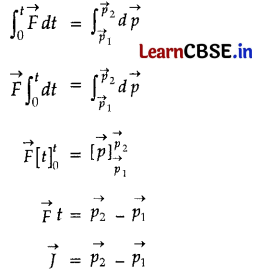
![]()
Question 32.
(a) What is conservative force ?
Answer:
Conservative force is a force if work done by or against the force in moving a body depends only on the initial and final positions of the body and not on the nature of path followed between initial and final positions, e.g., gravitational force, electrostatic force between two electric charges, all central forces, etc.
(b) Give conditions for no work.
Answer:
In physics no work is said to be done, if
(i) The applied force (F) is zero. A body moving with uniform velocity on a smooth surface has some displacement but no external force so in this case work done is zero.
(ii) The displacement (S) is zero. A labourer standing with a load on his head does no work.
(iii) The angle between force and displacement (θ) is π/2 rad or 90°. Then cos θ = cos 90° = 0. Thus, work done is also zero. In circular motion, instantaneous work done is always zero because of this reason.
(iv) The change in kinetic energy (∆KE) is zero.
OR
Derive the relation between torque and moment of inertia.
Answer:
Relation between torque and moment of inertia:
Consider a rigid body rotating about a given axis with a uniform angular acceleration α, under the action of a torque
Let the body consist of particles of masses m
1
, m
2
, m
3
, ……………., m
n
, at perpendicular distance r
1
, r
2
, r
3
, ……………, r
n
, respectively from the axis of rotation,(as shown in figure)
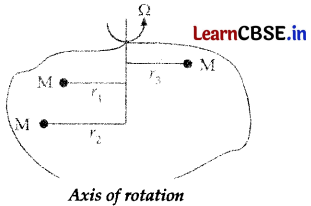
As the body is rigid, angular acceleration a of all the particles of the body is the same. However, linear accelerations of the particles depend on their distance from the axis. If a1, a, a …, a are the respective linear accelerations of the particles, then,
a
1
= r
1
α, a
2
= r
2
α, a
3
= r
3
α ……………..
Force on particle of mass in is
f
1
= m
1
a
1
= m
1
r
1
α
Moment of this force about the axis of rotation
f
1
× r
1
= (m
1
r
1
α) × r
1
= m
1
r
1
2
α
Similarly, moments of forces on other particles about the axis of rotation are m
2
r
2
2
α, m
3
r
3
2
α, …………….. m
n
r
n
2
α.
∴ Torque acting on the body
τ = m
1
r
1
2
α + m
2
r
2
2
α + m
3
r
3
2
α, ……………….. m
n
r
n
2
α
τ = (m
1
r
1
2
+ m
2
r
2
2
+ m
3
r
3
2
+ ………………. m
n
r
n
2
)α
So, τ = \(\left(\sum_{i=1}^{i=n} m_i r_i^2\right)\) α
τ = Iα
where I = \(\sum_{i=1}^{i=n} m_i r_i^2\) = moment of inertia of the body about the given axis of rotation.
\(\vec{\tau}=I \vec{\alpha}\)
![]()
Question 33.
Find the excess pressure :
(i) inside a liquid drop,
(ii) inside soap bubble,
(iii) inside an air bubble in liquid.
Answer:
(i) Inside a liquid drop :
Consider a liquid drop of radius R. The molecules lying on the surface of liquid drop, due to surface tension will experience resultant force acting inward perpendicular to the surface.
Let S = Surface tension of liquid drop
P = excess pressure inside the drop
Due to excess of pressure, let there be increase in the radius of the drop by a small quantity δR as shown in figure.
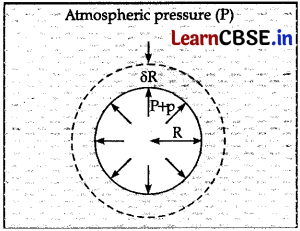
Then work done by the excess pressure.
W= Force × Displacement
= (Excess pressure × Area × Increase in radius)
= p × 4πR
2
× δR ……………..(i)
Increase in surface area of the drop = Final surface area – Initial surface area
= 4π (R + δR)
2
– 4πR
2
= 4π [R
2
+ 2R(δR) + (δR)
2
– R
2
]
= 8πRδR
[Neglecting, (δR)
2
being very very small]
∴ Increase in surface energy = increase in surface area × surface tension
= 8πR(δR) × S ………………(ii)
As the increase in surface energy is at the cost of work done by the excess pressure, therefore from (i) and (ii) p × 4πR
2
× δR = 8πRδR × S
p = \(\frac{2 S}{R}\)
(ii) Inside a soap bubble. Consider a soap bubble of radius R the molecules lying on the surface of liquid bubble will experience a resultant force acting on water perpendicular to the surface due to the surface tension.
Let S = surface tension of the soap solution,
p = excess of pressure inside the bubble.
Due to it, let there be increase in the radius of the bubble by a small amount δR in fig.
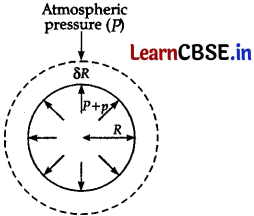
Then work done,
W = Force × Distance
= (Excess pressure × Area) × Increase in radius
= p × 4πR
2
× δR ………………………(iii)
The soap bubble has two free surface, one outside the bubble and one inside the bubble when soap solution and air are in contact.
∴ The effective increase in surface area of the bubble
= 2 [Final S.A – Initial SA]
= 2 [4π (R + δR)
2
– 4πR
2
]
= 2 × 4π [R
2
+ 2R(δR) + (δR)
2
– R
2
]
= 8π × 2R (δR)
[Neglecting (δR)
2
, being very small] = 16nRδR
∴ Increase in surface energy = Increase in surface area × Surface tension
= 16πRδR × S ………………..(iv)
∵ Increase in surface energy is as the cost of work done by the excess pressure therefore from Eqs. (iii) and (iv),
p × 4πR
2
× (δR) = 16πR(δR) × S
or p = \(\frac{4 S}{R}\)
(iii) Inside an air bubble in liquid. Consider an air bubble of radius R. Just inside a liquid of surface tension S.
Atmospheric pressure + Pressure of liquid = P

The air bubble will have only one free surface as shown in figure. It can be shown that the pressure inside the air bubble is given by
p = \(\frac{2 S}{R}\)
OR
(a) Liquid drops are spherical in shape. Why ?
Answer:
Liquid drops :
One consequence of surface tension is that free liquid drops and bubbles are spherical if effects of gravity can be neglected.
A liquid air interface has energy, so for a given value the surface with minimum energy is the one with the least area. The sphere has this property. So, if gravity and outer forces were ineffective, liquid drops would be spherical and the pressure inside a spherical drop is more than that the pressure outside.
(b) Why do cloud float in the sky ?
Answer:
Clouds are composed of tiny water droplets. Since, terminal velocity is proportional to the square of radius, the terminal velocity of tiny droplets is too small and hence they remain in sky.
(c) Give two similarities and dissimilarities between friction and viscosity.
Answer:
Similarities between friction and viscosity:
- Viscosity is due to the friction between neighbouring particles in a fluid those are moving at different velocities. Fluid friction is also called as viscosity.
- Viscosity and friction both depend on the size and shape of its particles and the attractions between the particles.
Dissimilarities:
- Viscosity is the measure of the resistance of a fluid, which is deformed by either shear stress or tensile stress. While friction is caused by the contact of two rough surfaces.
- The viscosity of a fluid depends on the temperature. It decreases as the temperature is increased. While friction depends on the surface area.